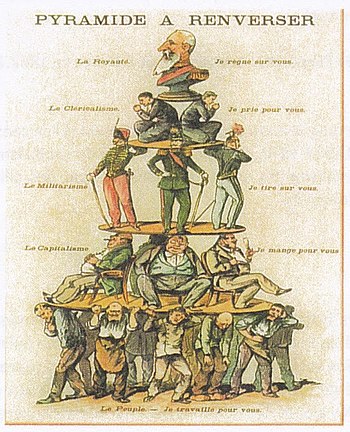
Back بنية اجتماعية Arabic بناء اجتماعى ARZ Estructura social AST Sosial struktur Azerbaijani Социална структура Bulgarian সামাজিক কাঠামো Bengali/Bangla Estructura social Catalan Sociální struktura Czech Sozialstruktur German Estructura social Spanish

| Part of a series on |
| Sociology |
|---|
 |
| Part of a series on |
| Anthropology |
|---|
 |
In the social sciences, social structure is the aggregate of patterned social arrangements in society that are both emergent from and determinant of the actions of individuals.[1] Likewise, society is believed to be grouped into structurally related groups or sets of roles, with different functions, meanings, or purposes. Examples of social structure include family, religion, law, economy, and class. It contrasts with "social system", which refers to the parent structure in which these various structures are embedded. Thus, social structures significantly influence larger systems, such as economic systems, legal systems, political systems, cultural systems, etc. Social structure can also be said to be the framework upon which a society is established. It determines the norms and patterns of relations between the various institutions of the society.
Since the 1920s, the term has been in general use in social science,[2] especially as a variable whose sub-components needed to be distinguished in relationship to other sociological variables, as well as in academic literature, as result of the rising influence of structuralism. The concept of "social stratification", for instance, uses the idea of social structure to explain that most societies are separated into different strata (levels), guided (if only partially) by the underlying structures in the social system. There are three conditions for a social class to be steady, that of class cohesiveness, the self-consciousness of classes, and the self-awareness of one's own class.[3] It is also important in the modern study of organizations, as an organization's structure may determine its flexibility, capacity to change, etc. In this sense, structure is an important issue for management.
On the macro scale, social structure pertains to the system of socioeconomic stratification (most notably the class structure), social institutions, or other patterned relations between large social groups. On the meso scale, it concerns the structure of social networks between individuals or organizations. On the micro scale, "social structure" includes the ways in which 'norms' shape the behavior of individuals within the social system. These scales are not always kept separate. For example, John Levi Martin has theorized that certain macro-scale structures are the emergent properties of micro-scale cultural institutions (i.e., "structure" resembles that used by anthropologist Claude Levi-Strauss). Likewise, in ethnography, a recent study describes how indigenous social structure in the Republic of Panama changed macro social structures and impeded a planned Panama Canal expansion.[4] Marxist sociology has also historically mixed different meanings of social structure, though doing so by simply treating the cultural aspects of social structure as phenomenal of its economic aspects. [citation needed]
Social norms are believed to influence social structure through relations between the majority and the minority. As those who align with the majority are considered 'normal', and those who align with the minority are considered 'abnormal', majority-minority relations create a hierarchical stratification within social structures that favors the majority in all aspects of society.
- ^ Olanike, Deji (2011). Gender and Rural Development By. LIT Verlag Münster. p. 71. ISBN 9783643901033.
- ^ Merton, Robert. 1938. "Social Structure and Anomie." American Sociological Review 3(5):672–82.
- ^ Morgan, B. S. (1984). "Social Geography, Spatial Structure and Social Structure". GeoJournal. 9 (3): 301–310. doi:10.1007/BF00149044. ISSN 0343-2521. JSTOR 41143395.
- ^ Muller-Schwarz, Nina K. (2015). The Blood of Victoria no Lorenzo: An Ethnography of the Solos of Northern Coco Province. Jefferson, NC: McFarland Press.